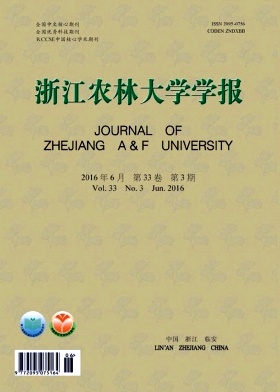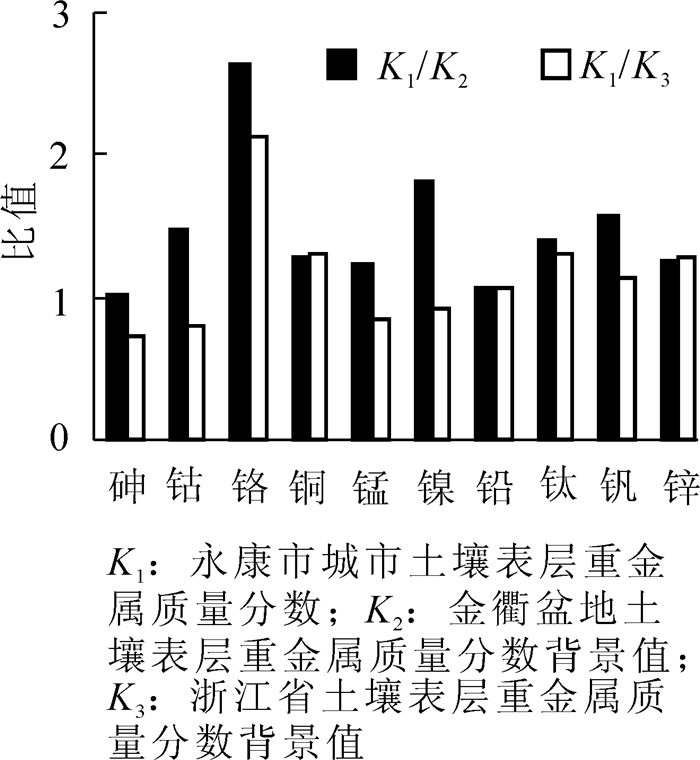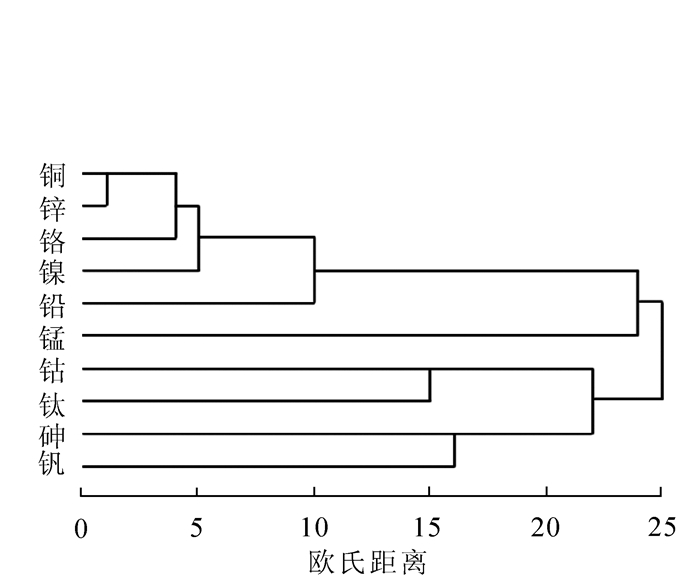-
城市土壤作为地球土壤圈的重要组成部分,是构成城市环境的一部分,在人类居住环境质量、城市生态功能等方面有着重要的作用[1]。随着城市化的推进,人类活动将大量的污染物带入城市环境中[2],城市土壤中的重金属通过地面扬尘、食物链传递等途径破坏城市生态环境,造成了城市环境污染,并在一定程度上威胁人类的健康[3]。中国对于城市土壤重金属的研究起步较晚,但目前相关学者已对许多大中型城市[4],如海口[3]、北京[5]、南京[6]等地土壤铅(Pb),锌(Zn),铜(Cu),铬(Cr),钛(Ti)等重金属污染含量、分布、来源等方面进行研究。浙江省永康市主要以防盗门、滑板车、五金机械、建材等为主要支柱产业,产业的集聚,给当地带来了巨大的规模效应,但却对周边环境造成了一定程度的影响[7]。本研究基于浙江省土壤表层背景值[8]和金衢盆地土壤背景值[9],研究土壤表层重金属来源,为全面了解永康城市土壤表层重金属的污染现状积累基础资料,准确评估永康市城市发展、规划管理及环境保护提供参考依据。
HTML
-
永康市,隶属浙江省金华市,位于浙江省中部低山丘陵地区,地理坐标为28°46′~29°07′N,119°53′~120°21′E。永康市是浙江中部城市群副中心城市,五金机械、电动工具、防盗门、保温杯、滑板车等制造业集中,是全国现代五金产业中心之一[7]。本次研究土壤采集的采样点遍及永康市城市范围,西启城西新区,东至五金工业园,北启西城街道,南至江南街道。
-
本研究在永康市城区7种不同土地利用类型内采集土壤样品,利用手持式能量色散型X射线荧光分析仪研究砷(As),钴(Co),铬(Cr),铜(Cu),锰(Mn),镍(Ni),铅(Pb),钛(Ti),钒(V),锌(Zn)共10种重金属元素的特征。
-
本次土壤采集的采样点按照《全国土壤污染状况调查点布置技术规定》进行布点,并参照土地利用类型,在7种土地利用类型上布置样点共计203个,于2014年10月17日至2014年10月18日在永康市市区进行现场土壤样本采样。在203个样点中,交通用地24个,工业用地25个,住宅用地30个,市政文教用地11个,公园绿地18个,林地33个,耕地62个。
-
土壤样品的元素质量分数分析利用X-MET7000手持式能量色散型X射线荧光(EDXRF)分析仪,测试完成于浙江农林大学生态学实验室。手持式能量色散X射线荧光分析仪(国家农业信息化工程技术研究中心、北京普析通用仪器有限公司研制),配置Ag靶微型X光管、Al+Mo滤片、电子冷却S-i PIN探测器。测试电压30 kV,测试电流40 μA。
-
单因素评价分析可以分别反映不同污染物对环境的污染程度。在本研究中,为了同时反映当地区域的土壤表层重金属特征,以金衢盆地土壤元素背景值作为重金属评价标准的临界值。Pi=Ci/Si。其中:Pi为第i种重金属的污染分指数;Ci为第i种重金属元素的实测质量分数;Si为重金属评价标准的临界值,本研究中为金衢盆地土壤元素背景值[7]。Pi≤1表示未污染,1<Pi≤2表示存在潜在污染,2<Pi≤3表示造成轻度污染,Pi>3表示当地区域土壤已受到该元素重度污染。
-
内梅罗指数法是当前国内外进行综合污染指数计算的最常用方法之一。公式为:${P_n} = \sqrt {\frac{{P_{{\text{imax}}}^{\text{2}} + P_{{\text{iave}}}^{\text{2}}}}{2}} $。其中:Pn为内梅罗污染综合指数;Pimax为污染物种最大的污染指数;Piave为各污染元素指数的算术平均值。根据内梅罗污染指数,可将污染等级划分为5个不同等级[10-12],具体划分标准如表 1。
土壤综合污染等级 土壤综合污染指数 污染程度 污染水平 Ⅰ Pn≤0.7 安全 清洁 Ⅱ 0.7 < Pn≤1.0 警戒线 尚清洁 Ⅲ 1.0 < Pn≤2.0 轻污染 污染物超过起初污染值,作物开始污染 Ⅳ 2.0 < Pn≤3.0 中污染 土壤和作物污染明显 Ⅴ Pn>3.0 重污染 土壤和作物污染严重 Table 1. Classification standard of the Nemerow integrated pollute index
2.1. 样地选取与取样
2.2. 样品测试
2.3. 数据处理
2.3.1. 单因素评价分析
2.3.2. 内梅罗污染综合指数评价
-
永康市城市土壤表层重金属元素质量分数如表 2所示。重金属砷、钴、铬、铜、锰、镍、铅、钛、钒、锌在永康市城市土壤表层的平均质量分数分别为6.57,10.57,119.55,22.97,528.51,22.45,37.67,5 751.81,84.37,90.25 mg·kg-1。
项目 元素质量分数/(mg•kg-1) 砷 钴 铬 铜 锰 镍 铅 钛 钒 锌 最小值 0;01 0;12 56;43 1;41 53.67 8;28 1.80 2 628;59 0;89 39.21 最大值 46.75 66;49 740;82 440;55 1 728;69 78.11 264.01 10 244.50 229;47 932.17 平均值 6.57 10.57 119.55 22;97 528.51 22;45 37.67 5 751.81 84;37 90;25 变异系数/%, 105.21 92.80 47;46 176.97 54.13 34;95 68.19 23.13 109.67 94;65 金衢盆地背景值 6.49 7;20 45.37 18.03 429.10 12.45 35.12 4 091.00 53.51 72.13 浙江省背景值 9.20 13.20 55;99 17.60 620.51 24;60 35.70 4 406.11 73;60 70;60 说明: 样本数n=203 Table 2. Concentration of heavy metals of the soils in Yongkang
本研究中,变异系数值越大则表明该重金属元素在土壤中的分布受人为因素影响越大,反之则表明受自然源控制显著[13]。由表 2可知:永康市城市土壤表层重金属质量分数的离散程度较大,其中铜质量分数的变异系数最高,属强变异;钒和砷的变异系数次之,同属强变异。由此可见:永康市人为活动对城市土壤中重金属质量分数的干扰程度较强,部分区域的重金属污染已比较显著[14]。
永康市城市土壤表层重金属质量分数与浙江省土壤表层背景值和金衢盆地土壤背景值的比值如图 1所示,其中,金属铬有明显的富集现象,其质量分数分别是浙江省土壤表层背景值的2.1倍和金衢盆地土壤背景值的2.6倍。
-
运用单因素污染指数对永康市城市土壤表层中10种重金属进行污染程度评价,评价结果如表 3和表 4所示。由表 3可知:永康市城市土壤表层受重金属污染的状况并没有十分严重,除铬的污染程度达到轻度污染,其余各元素都处于潜在污染。各元素的染指数由大到小依次为铬>镍>钒>钴>钛>铜>锌>锰>铅>砷。由表 4可知:铬在研究区的污染程度最为普遍,所有样点的土壤表层都在一定程度上受到该元素的污染,表现为重度污染样点占所有采样点的14.78%,轻度污染样点占所有采样点的72.91%。
项目 砷 钴 铬 铜 锰 镍 铅 钛 钒 锌 最小值 0.002 0.016 1.243 0.078 0.125 0.665 0.051 0.643 0.017 0.544 最大值 7.203 9.234 16.328 24.434 4.027 6.274 7.514 2.944 4.288 12.943 平均值 1.012 1.468 2.635 1.274 1.232 1.803 1.073 1.406 1.577 1.251 污染程度 潜在污染 潜在污染 轻度污染 潜在污染 潜在污染 潜在污染 潜在污染 潜在污染 潜在污染 潜在污染 Table 3. Single-factor pollution index of heavy metals of city topsoil in Yongkang
污染程度 砷 钴 铬 铜 锰 镍 铅 钛 钒 锌 未污染 120 86 0 131 91 3 115 11 106 110 潜在污染 54 77 25 55 89 142 79 180 10 77 轻度污染 17 18 148 4 18 50 5 12 26 7 重度污染 12 22 30 13 5 8 4 0 61 9 Table 4. Results of city topsoil single-factor pollution index of heavy metals in Yongkang
-
单因素评价分析虽然能较明显地反映出各重金属元素对土壤的污染程度,但由于土壤中各重金属元素间存在一定的联系,共同对土壤产生作用,所以运用单因素评价对土壤污染评价并不能如实反映各重金属元素的共同作用。本研究用内梅罗综合污染指数法来评价永康市城市表层土壤重金属元素的综合污染程度。由表 5可知:永康市城市表层土壤受重金属的复合污染已不容忽视,永康市城市表层土壤的平均内梅罗综合污染指数为2.63,为中度污染,此时土壤和作物相应也受到中等程度的重金属污染。不同用地类型下的城市表层土壤均呈现为轻度及以上污染水平,平均内梅罗综合污染指数由高到低排序为:工业用地>交通用地>公园绿地>住宅用地>林地>市政文教用地>耕地。
永康市 交通用地 工业用地 住宅用地 市政文教用地 公园绿地 林地 耕地 最大值 17.94 6.59 17.94 10.60 1.32 6.73 5.35 4.33 最小值 0.88 1.48 1.82 1.37 2.11 1.88 0.99 0.87 平均值 2.63 3.20 3.74 2.72 1.88 2.84 1.98 1.83 污染程度 中度污染 重度污染 重度污染 中度污染 轻度污染 中度污染 轻度污染 轻度污染 Table 5. Nemerow integrated pollute index of heavy metals of city topsoil in cultivated land
-
相关系数(r)是用于研究变量之间线性相关程度的指标[15]。在本研究中,相关系数的值代表各金属元素的同源性,若为正代表两者具有同源的可能性,反之亦然;而相关系数的绝对值越大,说明变量间的线性相关越强,同源的可能性越大。通过表 6可知:永康市城市土壤表层中大多数重金属之间存在着显著或极显著的相关性,其中,66.67%为正相关关系,33.33%为负相关关系。铜和锌的相关性最大,为0.894,呈极显著正相关;铬和铜、铬和镍、铜和镍、铬和锌的相关性次之。由此可知:研究区内的土壤表层中,铬、铜、镍、锌这4种重金属污染可能具有相同的污染源。与此同时,锌和铅、锌和镍、铅和镍均呈极显著正相关,且相关系数较大;钴与钛也呈极显著正相关。
砷 钴 铬 铜 锰 镍 铅 钛 钒 锌 砷 1 钴 0.281** 1 铬 0.211** 0.128 1 铜 0.083 -0.064 0.800** 1 锰 0.121 0.193** 0.165* 0.145* 1 镍 0.195LL -0.023 0.784** 0.735** 0.025 1 铅 -0.230** -0.109 0.348** 0.597** 0.080 -0.427** 1 钛 -0.074 0.500** -0.249** -0.268** 0.072 -0.280** -0.054 1 钒 0.451** -0.126 0.148* 0.084 -0.001 0.155* -0.119 -0.419** 1 锌 0.103 -0.089 0.717** 0.894** 0.255** 0.643** 0.641** -0.252** 0.102 1 说明: **P < 0.01; *P < 0.05 Table 6. Relation coefficient of heavy metals of the urban soils in Yongkang
-
对研究区采集的203个样本得到的砷、钴、铬、铜、锰、镍、铅、钛、钒、锌等10种重金属质量分数进行主成分分析,分析得出主成分贡献率、累计贡献率、因子负荷矩阵如表 7和表 8所示,其中旋转方式为最大方差旋转。由结果分析可知,永康市城市土壤表层重金属污染来源主要由3个主成分所支撑,累积贡献率为72.20%,说明该结果在很大程度上能真实地反映出永康市城市土壤表层重金属污染来源的情况。其中,3个主成分因子F1,F2和F3对永康市城市土壤表层重金属污染的贡献率分别为37.88%,17.55%和16.77%。表 8为永康市城市土壤表层重金属主成分分析的因子载荷矩阵。由表 8可知:主成分因子F1包括铬、铜、镍、铅、锌,其贡献率为37.88%。由于永康市五金机械、防盗门、保温杯等制造业集中,而铬、镍是不锈钢的主要化学成分,所以工业来源是铬与镍的主要来源之一;铜、铅通常被认为与交通运输状况有关,主要受机动车污染排放影响[16-17],土壤中的铜、铅也来源于工业“三废”排放、城市生活垃圾和废水;研究表明:土壤中所累积的锌元素主要来源汽车轮胎的老化[4, 18-19]。近几年来,永康市民用汽车拥有量由2009年的9.5万辆[20]增长到了2013年的19.1万辆[21],短短4 a总量增长了1倍多。因此,因子F1主要可以归纳为是五金业与交通源的混合源。砷和钒在因子F2中有较高的负荷,因子F2的贡献率为17.55%。已知土壤中钒元素主要来源于工业生产与“三废”排放;永康市城市土壤表层中砷的质量分数与金衢盆地土壤背景值较为接近,说明其主要受土母质的影响。因而可知,因子F2可以归纳为工业与自然源的混合源。因子F3主要有钴与钛元素,其贡献率为16.76%。据了解,钴元素多用于硬质合金、磁铁、陶瓷和特殊玻璃的制造;而钛元素多用于合金的制造,也常用于油漆、橡胶、纸的颜料和某些轻质材料的制造。因此,因子F3也可以归结于五金业在永康市的盛行。
主成分因子 旋转前 旋转后 特征根 贡献率/% 累计贡献率/% 特征根 贡献率/% 累计贡献率 /% F1 3.85 38.50 38.50 3.79 37.88 37.88 F2 1.72 17.24 55.74 1.76 17.55 55.43 F3 1.65 16.46 72.20 1.68 16.76 72.20 Table 7. Characteristic vectors,eigenvalues and contribution rate of PCA in Yongkang
重金属元素 主成分因子负荷量 F1 F2 F3 砷 0.064 0.809 0.337 钴 -0.056 0.088 0.877 铬 0.851 0.230 0.146 铜 0.948 0.026 -0.015 锰 0.212 0.072 0.449 镍 0.825 0.195 -0.014 铅 0.701 -0.420 -0.080 钛 -0.286 -0.415 0.705 钒 0.071 0.804 -0.259 锌 0.924 0.015 0.000 Table 8. Factor load matrix of components
-
元素聚类分析可以有效地揭示不同元素间的来源相似性,可以用来检验主成分分析的结果。图 2为基于永康市203个城市土壤表层样点各重金属元素含量所得到的聚类树状图,研究区所研究的10种重金属可以大致分为4类,即铜、锌、铬、镍与铅聚成一类;钴与钛聚为一类;砷与钒聚为一类;锰自成一类。这与因子分析得到的分类结果几乎一致。聚类图上的距离轴反映了组间元素的关联程度,距离越小,关联度越显著[22],反之亦然。由此可知:在第一类中铜、锌、铬、镍这4个元素的关联度较为显著,其中铜和锌与铬和镍各自间的距离最近,这与利用元素相关性研究元素间来源的结果一致(表 7)。
3.1. 重金属质量分数特征
3.2. 土壤重金属污染评价
3.2.1. 单因素污染评价
3.2.2. 内梅罗污染指数评价
3.3. 土壤重金属来源分析
3.3.1. 重金属相关性分析
3.3.2. 主成分分析
3.3.3. 聚类分析
-
基于永康市城市表层土壤203个样本数据,分析测试了砷、钴、铬、铜、锰、镍、铅、钛、钒、锌等10种重金属元素的质量分数,评价了重金属的污染程度,并在一定程度上探讨了各元素的来源,得到以下结论:①永康市城市表层土壤中重金属砷、钴、铬、铜、锰、镍、铅、钛、钒、锌的平均质量分数分别为6.57,10.57,119.55,22.97,528.51,22.45,37.67,5 751.81,84.37,90.25 mg·kg-1。②永康市城市表层土壤受重金属污染的状况整体上并没有十分严重,但个别元素在局部地区污染较为严重,各元素的平均单因素污染指数由大到小依次为铬>镍>钒>钴>钛>铜>锌>锰>铅>砷。③研究区表层土壤均呈现为轻度污染及以上污染水平,平均内梅罗综合污染指数由高到低排序为:工业用地>交通用地>公园绿地>住宅用地>林地>市政文教用地>耕地。④永康市城市土壤表层重金属污染主要受工业制造、交通运输及自然成土的影响,其中以五金制造最为突出。












 DownLoad:
DownLoad:
